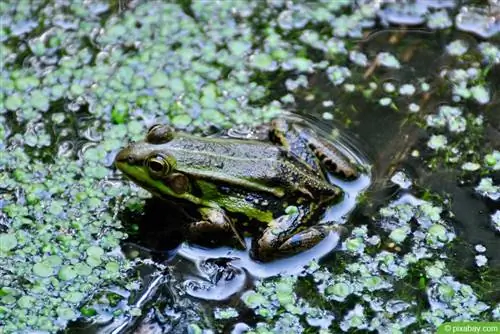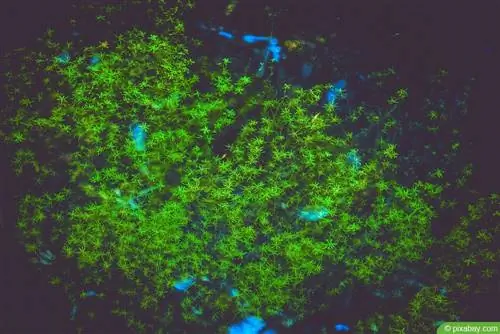- Author admin [email protected].
- Public 2023-12-17 03:39.
- Last modified 2025-01-24 12:45.
The dense-leaved waterweed is one of the most effective oxygen producers in garden ponds and aquariums. The perennial herbaceous plant thus makes an important contribution to maintaining water quality in the body of water. At the same time, it offers a hiding place and a source of food for fish and other aquatic creatures. However, the Elodea densa requires somewhat more extensive care than other underwater plants because it tends to crowd out other plants with its runners.
Profile
- Botanical name: Elodea densa (Syn. Egeria densa)
- Common names: Waterweed
- Plant family: Frogbite family (Hydrocharitaceae)
- Origin: Bolivia, Brazil and Argentina (distributed worldwide as a neophyte)
- Use: aquatic plant for garden ponds and aquariums
- Growth height: up to 3 m
- small, whorled leaves on long stems
- Flower: inconspicuous, white
- Flowering period: May to August
Appearance and growth
Waterweed is characterized by its long, flexible stems, which can reach several meters long in stagnant water. They are densely covered with small leaves up to three centimeters long, four of which emerge from the shoots in whorls. The leaf-covered stems usually remain quite narrow, but can branch out in a variety of ways. Under good conditions the plant grows very quickly. It thrives completely underwater; only its tiny, white flowers come to the surface. Roots form only to a very small extent, not only in the substrate, but also higher up on the stems.
Planting
If you want to integrate the easy-care Elodea into your aquarium or garden pond, you generally have two options. You can of course plant the plant in the substrate in the classic sense or simply let it float in the water. When planting, bundle several stems together and stick them into the substrate. This way you can achieve a very dense and lush planting. When planting, be sure to only plant the leafless stem. If it is too short, you can pluck individual leaves.
- Position in the aquarium tank: background
- Water depth in the garden pond: 70 to 150 cm
- preferably in bundles of 3 to 5 stems
Depending on the manufacturer, the Elodea densa is usually delivered in a bunch of five to ten shoots. In an aquarium, however, you shouldn't just stick them together in the substrate, but rather spread them out a little. The aquatic plant hardly grows in width at all, so you don't have to maintain any specific distances. Just a few stems are enough for aquariums or medium-sized ponds, as the plant spreads quickly in nutrient-rich waters.
Tip:
The floating variant can be a good option in breeding tanks that usually have to do without substrate.
Garden pond care
Although the waterweed does not impress with its appearance, it has other properties that make it the perfect pond plant. On the one hand, its rapid growth means it absorbs a lot of nutrients from the water, significantly reducing the risk of algae growth. The evergreen Elodea also produces oxygen all year round. It is well suited for beginners and is almost indestructible.
Location
Sunlight is necessary for the development of pond plants. However, the Elodea is not particularly sensitive, so it thrives well even in rather unfavorable conditions. Its robust nature allows it to thrive in both cold and warm waters.
- Light requirements: partial sun to partial shade
- Water quality: clear and clean
- also grows in slightly cloudy water
Wintering
Since waterweed is a rich green color even in winter, it is essential for supplying oxygen to the pond in the cold season. However, you must make sure that the wintergreen plant is located deep enough at the bottom of the pond. This is the only way to ensure that it does not freeze and thus suffer frost damage. Since the aquatic plant tends to overgrow, the cold season is a good opportunity to decimate the dense populations. It is best to thin out the shoots close to the surface in autumn to remove nutrients and biomass from the pond.
Note:
If the Elodea is cultivated in a bucket on the balcony or terrace, it overwinteres in the apartment or in a protected location at 5 to 10 degrees. It is important that the space offers enough light.
Care in the aquarium

The Elodea densa has the reputation of being quite easy to care for, even in an aquarium culture. It has the ability to adapt to very different circumstances without sacrificing its enormous growth. However, a few basic conditions are necessary for it to thrive.
Lighting
In aquariums, the Elodea needs artificial lighting for he althy development. When choosing the lamp, make sure that you buy special plant lights.
- Lighting duration: 8 to 12 hours daily depending on location
- ideal wavelengths: blue light and red light
Planting substrate
There are a lot of things to consider when it comes to the type of planting substrate for aquariums. As soon as plants are to be anchored in the substrate, a suitable substrate is essential. Theoretically, the waterweed can also be cultivated in a free-floating manner, but it is usually planted for practical and visual reasons. It places no demands on the soil, so this can be chosen freely depending on the remaining plants.
- Aquarium gravel
- Aquarium sand
- colored gravel
- Planting substrate
- River gravel
General care instructions
Regardless of whether you want to cultivate Elodea in aquariums or ponds, there are a few basic things to consider:
Temperature and water quality
The Elodea also thrives in soft water, but it finds the best growth conditions in calcareous waters with a higher pH value. The cold water plant can only tolerate high temperatures for a short time. It should therefore not be cultivated at temperatures above 26 degrees Celsius, which is why it is not suitable for tropical aquariums.
- ideal temperature: 15 to 24 degrees
- maximum: 28 degrees (short term)
- minimum: 4 degrees
- pH value: 5.8 to 9.0
- calcareous (not below 3 °dH)
- no addition of carbon dioxide necessary
Fertilize
When it comes to fertilization, you don't necessarily have to help with Elodea densa. If other aquatic plants have already stopped growing, the waterweed is still growing quite well. You only need to fertilize the robust plant if visible deficiency symptoms occur. These can be recognized by weak growth or yellowish discoloration of the leaves.
- commercial liquid fertilizer for pond or aquarium plants
- Soil fertilizers are more flexible
- put less strain on the water
- available as balls or sticks
- press into the substrate near the roots
Note:
Never use garden or flower fertilizer for ponds and aquariums. The amounts of nutrients it contains can harm living creatures in the water.
Regular Cut
The enormous growth of the Elodea normally does not pose a significant problem because the long shoots can be easily shortened. One danger, however, is that other aquatic plants that are less likely to spread are crowded out on the ground. To prevent this, it has proven useful to place the other underwater plants in plant baskets in the pond. This means you can easily check regularly whether their roots are still free of waterweed shoots. Sharp plant scissors are recommended for pruning. If the shoots are simply snapped off by hand, this often leads to problems with new growth. In this case, a smooth, clean cut is the better alternative.
Tip:
Herbivorous fish such as the rudd (Scardinius erythrophthalmus) keep growth in check. A combination with hornwort also curbs rapid spread.
Propagate
The dense-leaved waterweed grows so quickly that even small, rootless shoots are enough to create entire underwater forests within a very short time. Even the smallest parts of plants that have become lodged in the feathers of water birds are enough to allow new plants to grow in other bodies of water. It is therefore easily possible to simply cut off a piece of the plant and reinsert it in a suitable place in the garden pond or aquarium tank.
- Cuttings (preferably head cuttings)
- Parts from 2 cm length
- when inserting into substrate: remove lower leaves
Diseases and pests
The aquatic plant is very robust. It only has problems when the water quality changes massively. It does not tolerate water that is too soft or has extremely low nutrient levels particularly well and slowly dies.

